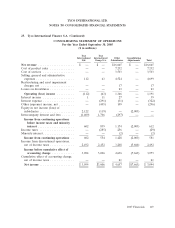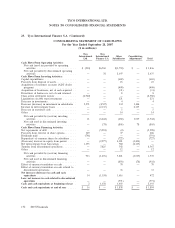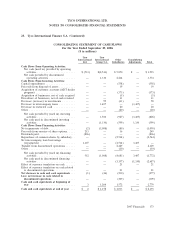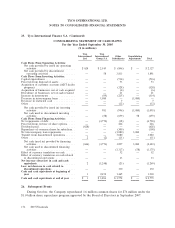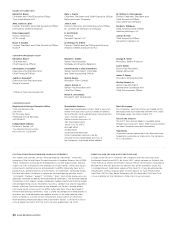ADT 2007 Annual Report Download - page 271
Download and view the complete annual report
Please find page 271 of the 2007 ADT annual report below. You can navigate through the pages in the report by either clicking on the pages listed below, or by using the keyword search tool below to find specific information within the annual report.
NON-GAAP MEASURES
FREE CASH FLOW RECONCILIATION
(in US$ millions) 2005 2006 2007
Net cash provided by operating activities $ 2,327 $ 1,993 $ 1,836
Decrease in sale of accounts receivable programs 8 8 7
Capital expenditures, net (463) (519) (646)
Acquisition of customer accounts (ADT dealer program) (328) (373) (409)
Purchase accounting and holdback liabilities (14) (7) (10)
Voluntary pension contributions 83 — 23
FREE CASH FLOW $ 1,613 $ 1,102 $ 801
2005 OPERATING INCOME (LOSS) BEFORE SPECIAL ITEMS
FIRE ELECTRICAL
ADT PROTECTION FLOW SAFETY & METAL CORPORATE OPERATING
(in US$ millions) WORLDWIDE SERVICES CONTROL PRODUCTS PRODUCTS AND OTHER INCOME
OPERATING INCOME (LOSS) $ 952 $ 202 $ 336 $ 278 $ 295 $ (872) $ 1,191
Divestiture Losses 11 4 2 6 23
SEC Settlement 50 50
Legacy Contingencies/Former Executives 70 70
OPERATING INCOME (LOSS) BEFORE SPECIAL ITEMS $ 963 $ 206 $ 336 $ 280 $ 295 $ (746) $ 1,334
2006 OPERATING INCOME (LOSS) BEFORE SPECIAL ITEMS
FIRE ELECTRICAL
ADT PROTECTION FLOW SAFETY & METAL CORPORATE OPERATING
(in US$ millions) WORLDWIDE SERVICES CONTROL PRODUCTS PRODUCTS AND OTHER INCOME
OPERATING INCOME (LOSS) $ 907 $ 239 $ 356 $ 202 $ 319 $ (653) $ 1,370
Separation costs (1) 50 49
Losses on divestitures 2 2
Reduction in estimated workers’ compensation liabilities (48) (48)
Voluntary Replacement Program 100 100
Former Management Settlement (72) (72)
OPERATING INCOME (LOSS) BEFORE SPECIAL ITEMS $ 909 $ 238 $ 356 $ 302 $ 319 $ (723) $ 1,401
“Organic revenue growth,” “free cash fl ow” (FCF), “operating income before
special items,” “operating margin before special items,” “operating income from
continuing operations before special items,” and “EPS from continuing operations
before special items” are non-GAAP measures and should not be considered
replacements for GAAP results.
Organic revenue growth is a useful measure used by the Company to mea-
sure the underlying results and trends in the business. The difference between
reported net revenue growth (the most comparable GAAP measure) and organic
revenue growth (the non-GAAP measure) consists of the impact from foreign
currency, acquisitions and divestitures, and other changes that do not refl ect the
underlying results and trends. Organic revenue growth is a useful measure of
the Company’s performance because it excludes items that: i) are not completely
under management’s control, such as the impact of foreign currency exchange;
or ii) do not refl ect the underlying growth of the Company, such as acquisition
and divestiture activity. It may be used as a component of the Company’s com-
pensation programs. The limitation of this measure is that it excludes items that
have an impact on the Company’s revenue. This limitation is best addressed by
using organic revenue growth in combination with the GAAP numbers.
FCF is a useful measure of the Company’s cash which is free from any
signifi cant existing obligation. The difference between cash fl ows from operat-
ing activities (the most comparable GAAP measure) and FCF (the non-GAAP
measure) consists mainly of signifi cant cash outfl ows that the Company believes
are useful to identify. FCF permits management and investors to gain insight into
the number that management employs to measure cash that is free from any
signifi cant existing obligation. It is also a signifi cant component in the Company’s
incentive compensation plans. The difference refl ects the impact from:
• the sale of accounts receivable programs,
• net capital expenditures,
• acquisition of customer accounts (ADT dealer program),
• cash paid for purchase accounting and holdback liabilities, and
• voluntary pension contributions.
The impact from the sale of accounts receivable programs and voluntary
pension contributions is added or subtracted from the GAAP measure because
this activity is driven by economic fi nancing decisions rather than operating
activity. Capital expenditures and the ADT dealer program are subtracted because
they represent long-term commitments. Cash paid for purchase accounting
and holdback liabilities is subtracted from Cash Flow from Operating Activities
because these cash outfl ows are not available for general corporate uses. The
limitation associated with using FCF is that it subtracts cash items that are ulti-
mately within management’s and the Board of Directors’ discretion to direct and
that therefore may imply that there is less or more cash that is available for the
Company’s programs than the most comparable GAAP measure. This limitation is
best addressed by using FCF in combination with the GAAP cash fl ow numbers.
FCF as presented herein may not be comparable to similarly titled measures
reported by other companies. The measure should be used in conjunction with
other GAAP fi nancial measures. Investors are urged to read the Company’s fi nancial
statements as fi led with the SEC, as well as the accompanying tables in this annual
report that show the reconciliation of FCF to Cash Flows from Operating Activities
(the most comparable GAAP measure).
The Company has presented its operating income, operating margin and EPS
from continuing operations before special items. Special Items include charges
and gains that may mask the underlying operating results and/or business trends
of the Company or business segment, as applicable. The Company utilizes these
fi nancial measures before special items to assess overall operating performance,
segment level core operating performance and to provide insight to manage-
ment in evaluating overall and segment operating plan execution and underlying
market conditions. Operating income from continuing operations before special
items is also a signifi cant component in the Company’s incentive compensation
plans. Operating income, operating margin and EPS from continuing operations
before special items are useful measures for investors because they permit more
meaningful comparisons of the Company’s underlying operating results and busi-
ness trends between periods. The difference between these measures and the
most comparable GAAP measures (operating income, operating margin and EPS
from continuing operations) consists of the impact of charges and gains related to
divestitures, acquisitions, restructurings (including transaction costs related to the
separations of Tyco Electronics and Covidien into separate public companies), and
other income or charges that may mask the underlying operating results and/or
business trends. The limitation of these measures is that they exclude the impact
(which may be material) of items that increase or decrease the Company’s reported
operating income, operating margin and EPS from continuing operations. This
limitation is best addressed by using these fi nancial measures in combination with
the most comparable GAAP measures in order to better understand the amounts,
character and impact of any increase or decrease on reported results.
Design: VSA Partners, New York Photos: Nat Clymer, Mike Hemberger, Mark Power Printing: CGI North America.
Cover and pages 1-12 were printed on 20% post-consumer recycled Forest Stewardship Council certified paper. The financial pages were printed on 30% post-consumer recycled paper.


